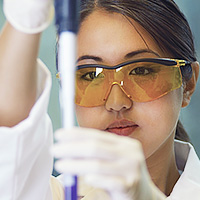Embryoid bodies (EBs) are three-dimensional aggregates comprised of human pluripotent stem cells (hPSCs). Within EBs, hPSCs undergo differentiation and cell specification along the three germ layers, which are commonly used as an assessment of the initial hPSCs' pluripotency. The protocol for formation of spin EBs can be used as a basis for the development of protocols for directed differentiation via EBs.
User-generated protocol
Confirmation of pluripotency by spin embryoid body formation
Introduction
Materials required
- 24-well plates, cell-culture treated, flat bottom
- 96-well plates, non-treated, V bottom
- Advanced RPMI 1640
(with glucose, sodium pyruvate, and non-essential amino acids; without L-glutamine and HEPES) - B-27 Supplement (50X), serum free
- DEF-CS COAT-1
- GlutaMAX-I (100X; 200 mM)
- PBS Dulbecco's with Ca2+ & Mg2+ (D-PBS +/+)
- PBS Dulbecco's w/o Ca2+ & Mg2+ (D-PBS –/–)
- Penicillin-streptomycin
(PEST; 10,000 units/ml of penicillin and 10,000 µg/ml of streptomycin) - TrypLE Select Enzyme (1X), no phenol red
(Thermo Fisher Scientific, Cat. # 12563011) - Y27632
Protocol
Medium preparation
Preparing the in vitro differentiation (IVD) medium
Prepare the IVD medium by adding 10 ml B-27 Supplement (50X), 5 ml GlutaMAX-I (100X), and 5 ml PEST to 500 ml of Advanced RPMI 1640. Mix the solution properly and carefully. The medium expires one month after the date of preparation.
Preparing the seeding medium
Prepare the seeding medium by adding Y27632 (to a final concentration 5 µM) to the IVD medium. Prepare fresh medium on the day of intended use.
Formation of spin EBs
- Warm the seeding medium to 37°C ± 1°C and all other reagents to room temperature (RT, 15–25°C) before use.
-
Wash one T25 flask containing confluent hPSCs with 5 ml D-PBS –/–.
NOTE: The entirety of this flask will be used for spin EB formation. Ensure other flasks or banked cells of equivalent passage number exist in order to preserve the original line.
- Add 500 µl of TrypLE Select (20 µl/cm2) and place the cells in an incubator at 37°C ± 1°C, 5% CO2, and >90% humidity for 5 min, or until cells start to detach.
- Add 5 ml of seeding medium and dissociate the cells, pipetting up and down until a single-cell suspension is achieved.
- Count the cells to determine the initial cell concentration.
- Make a cell suspension of 20 ml seeding medium containing 2.5 x 105 cells/ml.
- Seed 200 µl of the final cell suspension into each well of a 96-well plate (non-treated, V bottom), generating a seeding density of 5 x 104 cells/well.
- Centrifuge at 400g at RT for 5 min.
-
Place the 96-well plate in the incubator at 37°C ± 1°C, 5% CO2, and >90% humidity and let it sit undisturbed for 7 days to form EBs.
NOTE: Throughout this process, the cells are undergoing spontaneous differentiation. During the incubation period, directed differentiation protocols can be optimized and applied. Alternatively, if pluripotency is to be assessed, continue to the next section.
Spontaneous differentiation of spin EBs
Coating of the cell culture plate
- Dilute the required volume of DEF-CS COAT-1 in D-PBS +/+ before use. Make a 1:20 dilution.
- Mix the diluted DEF-CS COAT-1 solution gently and thoroughly by pipetting up and down.
- Add the appropriate volume of diluted DEF-CS COAT-1 solution to a 24-well plate (use 0.2 ml/cm2); make sure the entire culture surface is covered.
- Place the plate for a minimum of 20 min in an incubator at 37°C ± 1°C, 5% CO2, and >90% humidity or 0.5–3 hr at RT.
- Aspirate DEF-CS COAT-1 solution from plate immediately before use.
Transferring of spin EBs
- Warm IVD medium to 37°C ± 1°C.
- Add 1.5 ml of fresh, warm IVD medium to each well of the coated 24-well plate.
- Carefully detach and transfer the EBs using a pipette. Transfer 5–7 EBs to each well of the 24-well plate.
- Place the 24-well plate in the incubator at 37°C ± 1°C, 5% CO2, and >90% humidity and let it sit undisturbed for 4 days.
Exchanging the media
NOTE: Complete a 100% media change every 2–3 days.
- Warm IVD medium to 37°C ± 1°C.
- Completely exchange the media in each well of the 24-well plate (1.5 ml/well).
NOTE: 18–21 days after the start of spin EB formation, the cells are ready to be analyzed for the presence of specialized cells along the three germ layers. The number of days needed depends on the cell line.
Related products

User-generated protocols
User-generated protocols are based on internal proof-of-concept experiments, customer collaborations, and published literature. In some cases, relevant results are discussed in our research news BioView blog articles. While we expect these protocols to be successful in your hands, they may not be fully reviewed or optimized. We encourage you to contact us or refer to the published literature for more information about these user-generated and -reported protocols.
If you are looking for a product-specific, fully optimized User Manual or Protocol-At-A-Glance, please visit the product's product page, open the item's product details row in the price table, and click Documents. More detailed instructions for locating documents are available on our website FAQs page.
Questions? Protocols of your own that you would like to share?
Contact technical support Give feedbackTakara Bio USA, Inc.
United States/Canada: +1.800.662.2566 • Asia Pacific: +1.650.919.7300 • Europe: +33.(0)1.3904.6880 • Japan: +81.(0)77.565.6999
FOR RESEARCH USE ONLY. NOT FOR USE IN DIAGNOSTIC PROCEDURES. © 2025 Takara Bio Inc. All Rights Reserved. All trademarks are the property of Takara Bio Inc. or its affiliate(s) in the U.S. and/or other countries or their respective owners. Certain trademarks may not be registered in all jurisdictions. Additional product, intellectual property, and restricted use information is available at takarabio.com.



